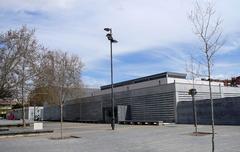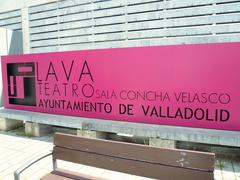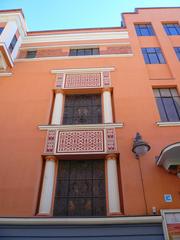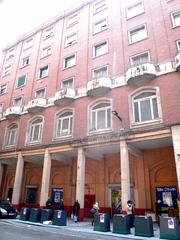
Plaza Mayor Valladolid: Visiting Hours, Tickets, and Historical Sites Guide
Date: 04/07/2025
Introduction
Plaza Mayor Valladolid is a monumental historic square at the heart of Valladolid, Spain. Renowned as the oldest Plaza Mayor in the country and a prototype for countless urban squares across Spain and Latin America, this plaza is a remarkable testament to the city’s evolving history, architectural innovation, and vibrant communal life. Whether you are passionate about history, architecture, or culture, Plaza Mayor Valladolid provides an immersive window into the city’s rich heritage, contemporary festivities, and everyday rhythms.
This comprehensive guide explores the square’s historical development, architectural features, cultural significance, practical visitor information—including visiting hours and ticketing—and travel tips. For further details and planning resources, consult the Valladolid Tourist Office and delve into architectural perspectives at Architecture of Cities.
Table of Contents
- Introduction
- Historical Overview
- Architectural Highlights
- Cultural and Social Significance
- Visitor Information
- Frequently Asked Questions (FAQ)
- Visuals and Media
- Related Articles and Links
- Conclusion
- References
Historical Overview
Medieval Origins and Growth
The site of today’s Plaza Mayor traces its origins to the 11th century, initially located just outside Valladolid’s earliest city walls. The city’s foundational growth began under Count Pedro Ansúrez, appointed by King Alfonso VI, with the first settlements clustered around Plaza de Santa María and adjacent churches. By the 13th century, the market was relocated to what would become Plaza Mayor, then known as Plaza del Mercado, marking the area as the city’s commercial and social epicenter.
The 1561 Fire and Urban Renewal
A catastrophic fire in 1561 devastated much of Valladolid, including the bustling Plaza del Mercado. In the aftermath, King Philip II commissioned Francisco de Salamanca to design a new square—Spain’s first geometrically planned plaza. Featuring a rectangular layout enclosed by uniform, arcaded buildings and orderly radiating streets, the new design revolutionized urban planning in Spain and served as a model for future plazas, including those in Madrid and Latin America (Architecture of Cities; Barceló Pin and Travel).
Civic and Cultural Evolution
From the late 15th century onward, the square solidified its role as Valladolid’s civic heart. The original town hall was built here in 1499, and the plaza became the venue for markets, royal proclamations, religious processions, and major festivals. During Valladolid’s brief tenure as the capital of Habsburg Spain (1601–1606), the plaza gained further prominence as the stage for national events.
Modern Transformations
The 19th and 20th centuries brought significant changes, including the replacement of the original town hall with the current Casa Consistorial and the addition of the bronze statue of Count Pedro Ansúrez in 1903. Recent upgrades, such as underground parking and surface renovations, have been sensitively integrated to preserve the plaza’s historic character (Portal de Turismo de Castilla y León).
Architectural Highlights
Layout and Style
Plaza Mayor’s geometric precision—a large rectangle, approximately 120 by 70 meters—creates a sense of enclosure and harmony. The surrounding uniform, multi-story buildings feature ground-floor arcades supported by robust stone columns, forming sheltered walkways lined with shops, cafés, and restaurants. The facades are characterized by regular windows and balconies, with a palette of warm earth tones and stone trim, blending Renaissance symmetry with Baroque ornamentation (Architecture of Cities).
The City Hall (Casa Consistorial)
Dominating the northern side, the Casa Consistorial is the architectural focal point of Plaza Mayor. Completed in the early 20th century, it features a symmetrical facade with three towers and a prominent central clock. The eclectic style integrates Renaissance and Baroque motifs, while the arcaded ground floor maintains continuity with the overall plaza design.
Materials and Adaptations
Locally sourced stone and brick are the primary materials, with arcades constructed from sturdy columns and arches. Upper stories are finished with stucco or painted plaster, and wrought iron is used extensively for balcony railings. Roofs are covered with terracotta tiles. Modern interventions—such as updated lighting and pavement—have been carefully designed to support accessibility and comfort without detracting from the square’s historic aesthetic (Architecture of Cities).
Cultural and Social Significance
Daily Life and Local Traditions
Plaza Mayor remains Valladolid’s vibrant social nucleus. Locals and visitors gather here for coffee, tapas, or simply to enjoy the lively atmosphere. The arcaded walkways shelter passersby and are favorite spots for informal meetings and people-watching. Street performers, musicians, and markets contribute to the dynamic energy, especially during afternoons and evenings (The Go Guy; Turispanish).
Festivals and Public Events
The plaza is the epicenter for Valladolid’s major celebrations, including Semana Santa (Holy Week) with its renowned processions, the September Feria de Valladolid, open-air concerts, Christmas markets, and civic ceremonies (Spotting History; Wikipedia). These events underscore the plaza’s role as a stage for both tradition and innovation.
Gastronomy and Arts
The arcades are home to some of Valladolid’s best cafés, tapas bars, and restaurants, offering local specialties like lechazo (roast lamb) and wines from the Ribera del Duero region (The Go Guy). The square is also connected to the city’s artistic and literary heritage, being close to the Casa de Cervantes and serving as a site for public art installations and exhibitions (The Crazy Tourist).
Visitor Information
Visiting Hours
- Plaza Mayor: Open public space, accessible 24 hours a day.
- Shops, Cafés, and Restaurants: Generally open from 10:00 AM to midnight (variations may occur on holidays or during festivals).
Tickets and Admission
- Access: Free entry to the plaza at all times.
- Events: Some special events or performances may require tickets, available in advance or from local tourist offices.
- Guided Tours: Walking tours featuring Plaza Mayor are available through the Valladolid Tourist Office and local providers; fees may apply.
Accessibility
- Flat, paved surfaces and wide arcades make the plaza wheelchair and stroller accessible.
- Underground parking is available beneath the square.
- Well-served by city buses and bike rentals; central location makes walking the best way to explore.
Guided Tours and Events
- Regular guided walking tours focus on the plaza’s architecture, history, and role in local culture.
- Major events include Semana Santa processions, Feria de Valladolid, concerts, and artisan markets. For schedules, check the Ayuntamiento de Valladolid.
Practical Travel Tips
- Best Time to Visit: Spring (April–June) and autumn (September–October) offer mild weather and vibrant local events.
- Footwear: Wear comfortable shoes for cobblestoned streets.
- Language: English is spoken in many establishments, but a translation app can be handy.
- Safety: The plaza is well-lit and generally very safe, but stay mindful of belongings during crowded events.
Nearby Attractions
- Cathedral of Valladolid
- National Sculpture Museum
- Casa de Cervantes
- Campo Grande Park
- Palace of Santa Cruz
All are within easy walking distance of Plaza Mayor, allowing for a full day of exploration (Spain This Way).
Frequently Asked Questions (FAQ)
Q: What are the Plaza Mayor Valladolid visiting hours?
A: The plaza is an open public space accessible 24 hours a day. Shops and restaurants typically open from 10:00 AM to midnight.
Q: Is there an entrance fee?
A: No, access to Plaza Mayor is free. Some special events may require tickets.
Q: Are guided tours available?
A: Yes, guided walking tours are offered by the Valladolid Tourist Office and other local providers.
Q: Is Plaza Mayor wheelchair accessible?
A: Yes, the plaza features flat, paved surfaces and is accessible to all visitors.
Q: What events take place in Plaza Mayor?
A: Major annual events include Semana Santa processions, Feria de Valladolid, concerts, markets, and cultural performances.
Q: Where can I park?
A: Underground parking is available directly beneath the plaza.
Visuals and Media
For an enhanced experience, explore virtual tours and high-resolution images of Plaza Mayor through official tourism websites and the Audiala app. Alt-text suggestions: “Plaza Mayor Valladolid visiting hours,” “Valladolid historical sites,” and “Plaza Mayor Valladolid tickets.”
Related Articles and Links
- Valladolid Tourist Office – Official Site
- Wikipedia: Valladolid
- Digital History: Plaza Mayor Reconstruction
Conclusion
Plaza Mayor Valladolid is a living testament to Spanish urban tradition, architectural excellence, and vibrant community life. Its harmonious design, rich festivities, and central location make it a highlight for every visitor to Valladolid. Plan your visit around the city’s cultural calendar, enjoy local gastronomy in the arcades, and take advantage of guided tours to deepen your appreciation of this historic square.
For more travel tips, current events, and exclusive guided content, download the Audiala app and follow us on social media. Whether you’re exploring for an afternoon or a week, Plaza Mayor Valladolid promises an unforgettable experience at the heart of Castile and León.
References
- Valladolid Tourist Office – Official Site
- Barceló Pin and Travel
- Wikipedia: Plaza Mayor, Valladolid
- Spotting History
- The Go Guy
- Turispanish
- The Tourist Checklist
- Portal de Turismo de Castilla y León
- Meticulous Meanderings
- Spain This Way
- Spain.info
- Rick Steves Forum
- Adventure Backpack
- What to Visit Where to Travel
- Best Time To Visit Valladolid
- Architecture of Cities








